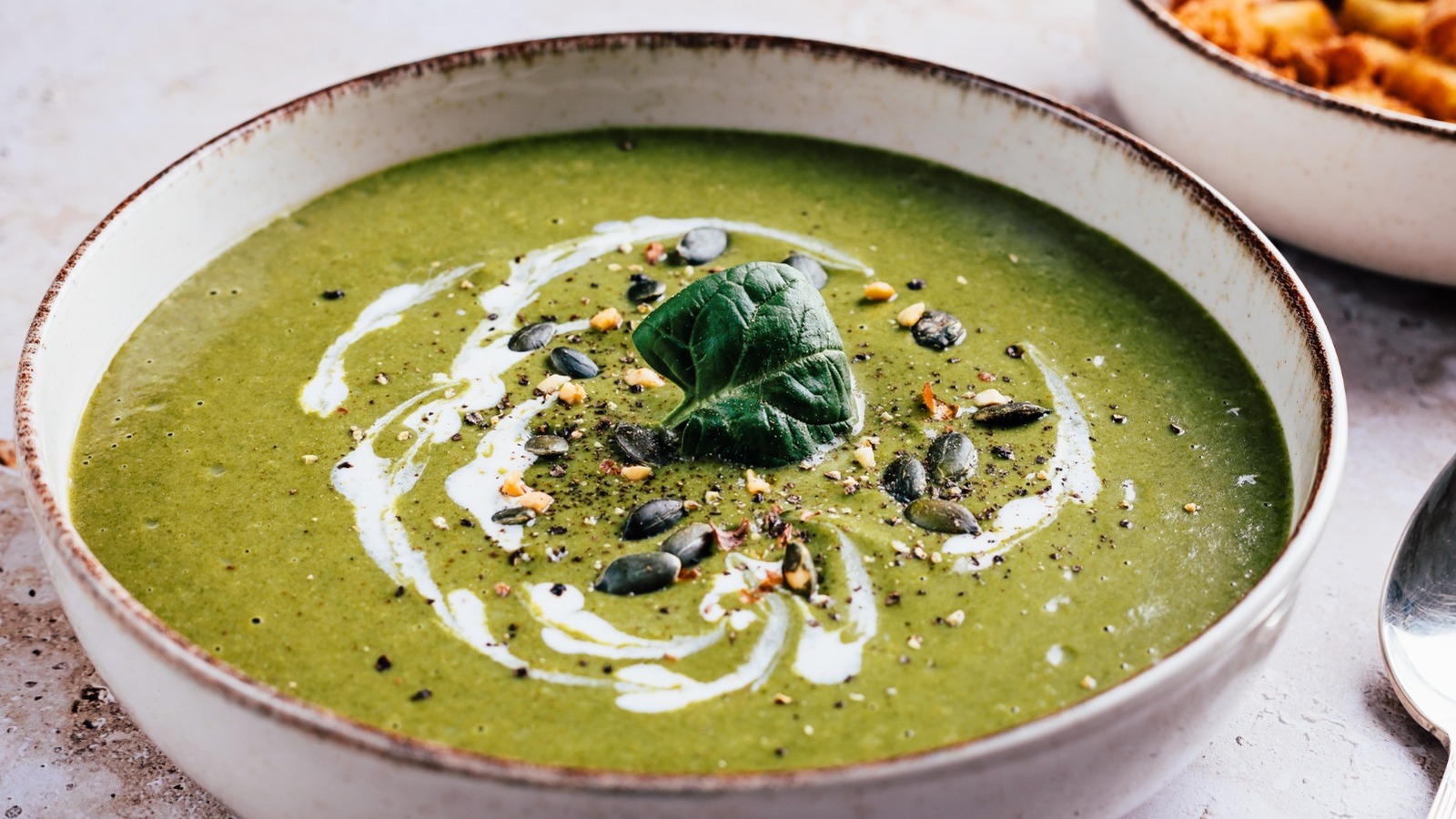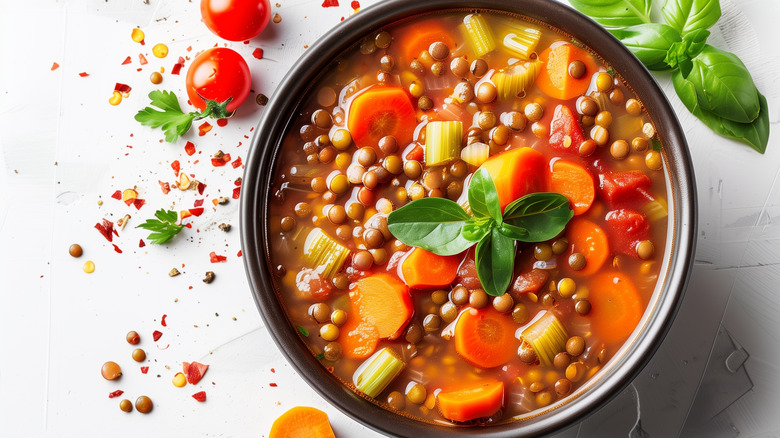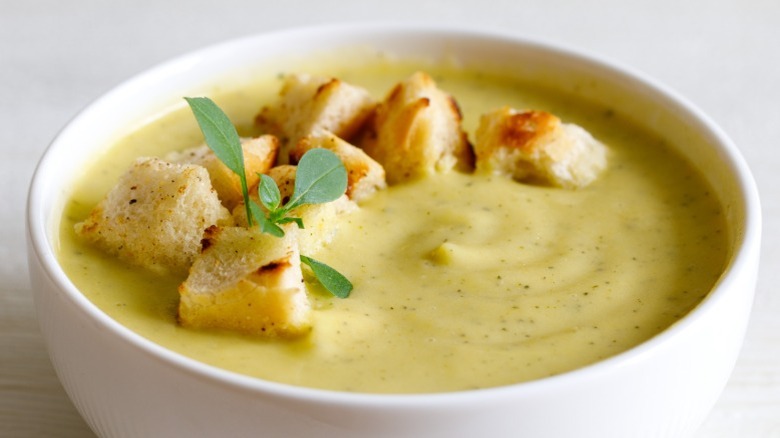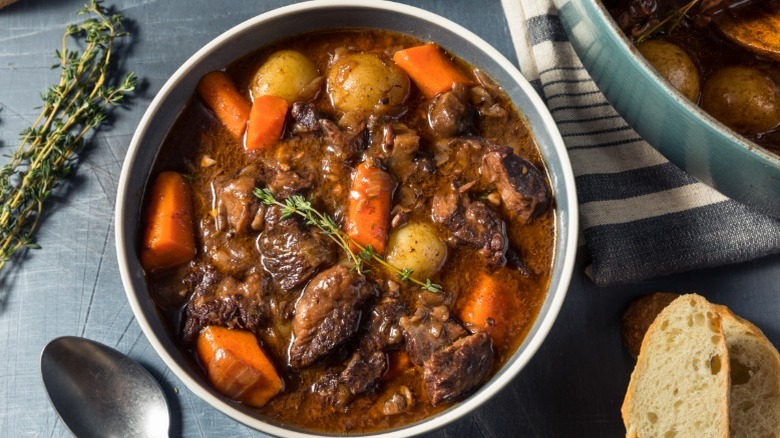From comforting autumnal roasted butternut squash purees to the refined simplicity of Julia Child’s Vichyssoise, there’s a soup for every occasion. And there are some simple tricks to ensure every soup you make will be a winner. So Chowhound asked Maxine Sharf, the culinary creator and recipe developer behind @maxiskitchen, for her easiest formula for a perfect soup, and she says the perfect ratio is 1 part protein, 2 parts vegetable, and 4 parts stock.
The basic framework begins with some pantry staples. “Start with aromatics like onions, garlic, and something from the carrot-celery family,” she says. Sautéing those in oil or butter starts the twin processes of the Maillard reaction and caramelization, layering rich flavor into your soup. This is also a good time to bloom spices and add a little salt and pepper.
Once those have softened, Sharf says it’s time to go in with some liquid. She recommends stock over broth since it has a heartier texture. Then, it’s time to add the stars of the show. Think proteins like chicken, sausage, or legumes and some veggies. But if you plan to puree it, hold back anything you’d like to keep whole. Finally, go in with some greens and add some brightness. “I always stir in something leafy (like kale, spinach, or herbs) and finish with a splash of acid, like lemon juice or vinegar. Taste and adjust seasoning… you’ll probably need to add more salt than you think,” Sharf advises.
The foolproof seasoning blend for perfect soup
Plenty of soups have their own unique (and uniquely delicious) flavor profiles, but certain seasonings and aromatics crop up time and time again. Knowing the most versatile pairings can help you figure out the best ingredients to keep on hand so you can reach for them the next time you get a craving for soup. “Garlic, onion, salt, and pepper are the nonnegotiables, they work in basically every cuisine,” Maxine Sharf says.
In terms of optional ingredients, Sharf highly recommends bay leaves. And it’s no wonder. Bay leaves are a criminally underrated ingredient, likely due to the myth that they don’t really taste of anything. But they have a herby, subtly floral flavor that brings a touch of complexity to any soup or broth without the risk of overwhelming the palate. She also recommends red pepper flakes if you want a little heat.
And according to Sharf, “Thyme and oregano are super-versatile too, especially for vegetable or chicken-based soups.” As long as you don’t go overboard, they also enhance flavors without overpowering. And they work well with almost any combination of ingredients. And the dried versions can sit in your pantry until you’re ready for a delicious, convenient, and simple upgrade to your soup — and plenty of other dishes at that.
Make a simple adjustment for delicious, creamy soup bases
Some of the finest soups out there rely on cream for a rich, silky finish. But you need to simmer off about a quarter of the broth to make room. You could start with less liquid, but that leads to a less flavorful broth.
Maxine Sharf says she uses 1 part dairy to 4 parts stock, but don’t just pour it in. Sharf notes, “It’s important to add dairy after taking the pot off the heat (or on low heat) so it doesn’t curdle.” And add the cream gradually to avoid ruining your soup in the final stretch. Pay close attention to things like temperature and texture. Be wary when using cream not to take things too far. Too much cream can make it overly rich or even a bit sweet.
To be safe, you can just add a little hint of richness and tang toward the end of cooking. Sharf sometimes adds a spoonful of sour cream to finish. If you plan to puree the soup, that may be all you need, especially with starchy ingredients like potatoes. Just note that you’ll have to add any ingredients you want to avoid pureeing at the end too, and since those need to stay on the heat to come to temperature (because they should already be cooked if they’re going in that late), you have to puree, add and heat any whole ingredients, then add the dairy off the heat at the very end.
The mistakes to avoid when making soup as a home cook
Being on the lookout for common soup mistakes can save you from lumpy, overly thick — or worse — flavorless soup. “Soup needs more salt than you think,” Maxine Sharf says. Because there’s so much liquid involved, you need a significant amount of salt to properly flavor the broth and intensify the natural flavors of your ingredients. Trust your instincts. “Taste as you go and don’t be afraid to add more,” she advises.
Also, be mindful of the temperature. It’s tempting to whack up the heat to help your ingredients tenderize and get food on the table faster, but don’t. High temperatures can result in overcooked ingredients and don’t do you any favors as far as developing flavor goes. According to Sharf, “A rolling boil can toughen meat and make veggies fall apart.” Simmering the ingredients gently is vital.
Finally, don’t be afraid to add a burst of freshness with some acid. Sometimes, it’s all you need to take a dish from good to great. “If it’s bland, try a splash of acid, more salt, or some extra spices,” Sharf suggests. It’s hard to overseason soup, so don’t be afraid to be liberal with your flavors.








